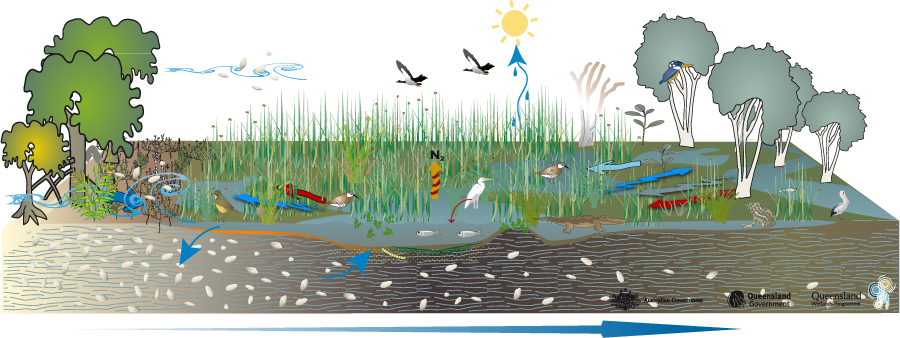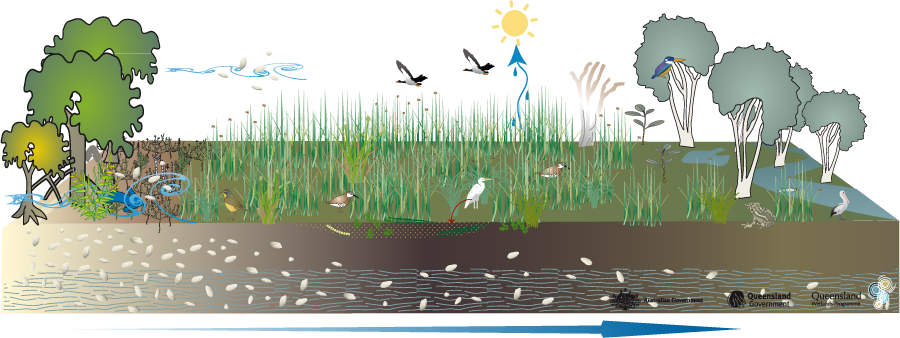|
|
Coastal and subcoastal saline swampCoastal and subcoastal saline swamp – FloraClick on elements of the model or select from the tabs below
Coastal saline swamps adjoin or merge with a wide range of other wetland types. On marine plains, they lie between saltmarsh wetlands and upland (non-wetland) ecosystems; on alluvial plains, they may lie between river channels/levees and the high ground at the floodplain edge, surrounded by infrequently inundated floodplain, Often they occur patchily within complexes of wetland types such as coastal melaleuca swamps and braided river channels. Frequently, the boundaries of each type are not clear and may change over time as determined by patterns of rainfall and flooding. Hydrology and climate can play a role in determining vegetation. More freshwater input can stimulate Melaleuca seedling growth and potentially dominate the vegetation community; alternatively, dead Melaleuca stumps may be present in these areas, indicating a relatively recent shift towards grasses. Regional ecosystemsTropical11.3.27x1c: Sedgelands on old marine plains. Occurs in depressions on old Quaternary estuarine deposits. These are seasonally inundated with fresh water but become more brackish as they dry. Dry out completely before the next season's rain. 3.3.58: Oryza rufipogon ± Eleocharis spp. closed tussock Grassland in seasonally inundated depressions. Occurs on seasonally inundated depressions on marine plains. 3.3.63: Closed sedge land dominated by Eleocharis dulcis. Occurs on seasonally flooded marine plains, in areas inundated with 15-40 cm of water in the wet season. Sub-tropical11.1.3a: Palustrine wetland (e.g. vegetated swamp). Melaleuca spp. and/or Eucalyptus tereticornis open-woodland to woodland. Mangrove trees and shrubs are often present, and there are sometimes scattered shrubs of Myoporum acuminatum. There is usually a dense ground layer of Sporobolus virginicus, with other species including Cynanchum carnosum, Fimbristylis ferruginea, Cyperus scariosus, C. polystachyos, Gymnanthera oblonga, Acrostichum speciosum and Centella asiatica. Occurs on transition zone between tidally inundated areas and areas under fresh water influence. 8.1.4: Paspalum spp. and Fimbristylis ferruginea sedgeland/grassland (estuarine wetland). Includes areas of deep open water with clumps of Schoenoplectus littoralis ± Eleocharis dulcis 11.3.27x1c: Sedgelands on old marine plains. Occurs in depressions on old Quaternary estuarine deposits. These are seasonally inundated with fresh water but become more brackish as they dry. Dry out completely before the next season’s rain. Last updated: 22 March 2013 This page should be cited as: Department of Environment, Science and Innovation, Queensland (2013) Coastal and subcoastal saline swamp – Flora, WetlandInfo website, accessed 8 May 2025. Available at: https://wetlandinfo.des.qld.gov.au/wetlands/ecology/aquatic-ecosystems-natural/palustrine/saline-swamp/flora.html |

 — Department of the Environment, Tourism, Science and Innovation
— Department of the Environment, Tourism, Science and Innovation




